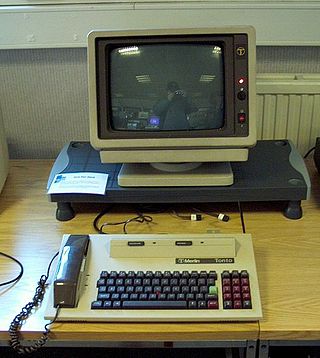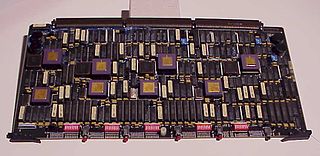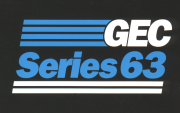Related Research Articles

The PDP–11 is a series of 16-bit minicomputers sold by Digital Equipment Corporation (DEC) from 1970 into the late 1990s, one of a set of products in the Programmed Data Processor (PDP) series. In total, around 600,000 PDP-11s of all models were sold, making it one of DEC's most successful product lines. The PDP-11 is considered by some experts to be the most popular minicomputer.

Ultrix is the brand name of Digital Equipment Corporation's (DEC) discontinued native Unix operating systems for the PDP-11, VAX, MicroVAX and DECstations.
GeoPort is a serial data system used on some models of the Apple Macintosh that could be externally clocked to run at a 2 megabit per second data rate. GeoPort slightly modified the existing Mac serial port pins to allow the computer's internal DSP hardware or software to send data that, when passed to a digital-to-analog converter, emulated various devices such as modems and fax machines. GeoPort could be found on late-model 68K-based machines as well as many pre-USB Power Macintosh models and PiPPiN. Some later Macintosh models also included an internal GeoPort via an internal connector on the Communications Slot. Apple GeoPort technology is now obsolete, and modem support is typically offered through USB.
Sequent Computer Systems was a computer company that designed and manufactured multiprocessing computer systems. They were among the pioneers in high-performance symmetric multiprocessing (SMP) open systems, innovating in both hardware and software.

Bell-Northern Research (BNR) was a telecommunications research and development company established In 1971 when Bell Canada and Northern Electric combined their R&D organizations. It was jointly owned by Bell Canada and Northern Telecom. BNR was absorbed into Nortel Networks when that company changed its name from Northern Telecom in the mid-1990s.
Pyramid Technology Corporation was a computer company that produced a number of RISC-based minicomputers at the upper end of the performance range. It was based in the San Francisco Bay Area of California

PRISM was a 32-bit RISC instruction set architecture (ISA) developed by Digital Equipment Corporation (DEC). It was the outcome of a number of DEC research projects from the 1982–1985 time-frame, and the project was subject to continually changing requirements and planned uses that delayed its introduction. This process eventually decided to use the design for a new line of Unix workstations. The arithmetic logic unit (ALU) of the microPrism version had completed design in April 1988 and samples were fabricated, but the design of other components like the floating point unit (FPU) and memory management unit (MMU) were still not complete in the summer when DEC management decided to cancel the project in favor of MIPS-based systems. An operating system codenamed MICA was developed for the PRISM architecture, which would have served as a replacement for both VAX/VMS and ULTRIX on PRISM.

International Computers Limited (ICL) was a British computer hardware, computer software and computer services company that operated from 1968 until 2002. It was formed through a merger of International Computers and Tabulators (ICT), English Electric Computers (EEC) and Elliott Automation in 1968. The company's most successful product line was the ICL 2900 Series range of mainframe computers.
CCI may refer to:
AT&T Computer Systems is the generic name for American Telephone & Telegraph's unsuccessful attempt to compete in the computer business. In return for divesting the local Bell Operating Companies, AT&T was allowed to have an unregulated division to sell computer hardware and software. The company made the 3B series computers.
Local Area Transport (LAT) is a non-routable networking technology developed by Digital Equipment Corporation to provide connection between the DECserver terminal servers and Digital's VAX and Alpha and MIPS host computers via Ethernet, giving communication between those hosts and serial devices such as video terminals and printers. The protocol itself was designed in such a manner as to maximize packet efficiency over Ethernet by bundling multiple characters from multiple ports into a single packet for Ethernet transport.

In computer programming, Franz Lisp is a discontinued Lisp programming language system written at the University of California, Berkeley by Professor Richard Fateman and several students, based largely on Maclisp and distributed with the Berkeley Software Distribution (BSD) for the Digital Equipment Corporation (DEC) VAX minicomputer. Piggybacking on the popularity of the BSD package, Franz Lisp was probably the most widely distributed and used Lisp system of the 1970s and 1980s.
Standard Telephones and Cables Ltd was a British manufacturer of telephone, telegraph, radio, telecommunications, and related equipment. During its history, STC invented and developed several groundbreaking new technologies including pulse-code modulation (PCM) and optical fibres.

The One Per Desk, or OPD, was an innovative hybrid personal computer/telecommunications terminal based on the hardware of the Sinclair QL. The One Per Desk was built by International Computers Limited (ICL) and launched in the United Kingdom in 1984. It was the result of a collaborative project between ICL, Sinclair Research and British Telecom begun in 1983, originally intended to incorporate Sinclair's flat-screen CRT technology.

The quad digital audio processor (QDAP) was a digital signal processor (DSP) based printed circuit card designed at Computer Consoles Inc. (CCI) in Rochester, NY. The QDAP was a service circuit module developed as part of the companies digital telephony switching system. The main function of the card was the processing of incoming digital audio to detect the speech patterns using speaker independent speech recognition. The CCI digital switch was deployed as part of the Digital Audio Intercept System, Automatic Voice Response (AVR), and Interactive Voice System (IVS) products. The initial QDAP board is notable for introducing speech recognition into the public telephone network to automate the handling of operator assisted telephone calls.

The GEC Series 63 was a 32-bit minicomputer produced by GEC Computers Limited of the UK during the 1980s in conjunction with A. B. Dick in USA. During development, the computer was known as the R Project. The hardware development was done in Scottsdale, Arizona whilst the software was the responsibility of GEC in Dunstable, UK. The hardware made early use of pipeline concepts, processing one instruction whilst completing the preceding one.
CT Connect is a software product that allows computer applications to monitor and control telephone calls. This monitoring and control is called computer-telephone integration, or CTI. CT Connect implements CTI by providing server software that supports the CTI link protocols used by a range of telephone systems, and client software that provides an application programming interface (API) for telephony functions.
The ICL DRS was a range of departmental computers from International Computers Limited (ICL). Standing originally for Distributed Resource System, the full name was later dropped in favour of the abbreviation.
Systime Computers Ltd was a British computer manufacturer and systems integrator of the 1970s and 1980s. During the late 1970s and early 1980s, Systime become the second largest British manufacturer of computers, specializing in the minicomputer market.
References
- ↑ Warner, Edward (1984-11-01). "Sperry launches 7000/40 32-bit superminicomputer". Computerworld. Retrieved 2022-06-28.
- ↑ "New Harris Computer Introduced" . Retrieved 2011-11-04.
- ↑ Leffler, Samuel J.; McCusick, Marshall K.; Karels, Michael J.; Quartermain, John S. (1989). The Design and Implementation of the 4.3BSD UNIX Operating System. Addison-Wesley. ISBN 978-0201061963.
- ↑ Gauthier, Richard. "Using the UNIX System" (PDF). Archived from the original (PDF) on 2017-05-06. Retrieved 2017-08-18.
- ↑ OLMOS, DAVID (1988-12-06). "Computer Consoles to Be Acquired by British Firm". Los Angeles Times. Retrieved 2017-08-18.
- ↑ Irvine signs on, STC Gazette February 1990, STC PLC